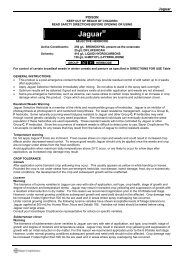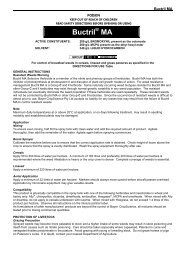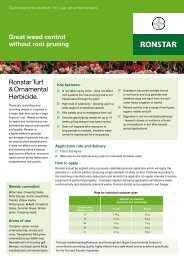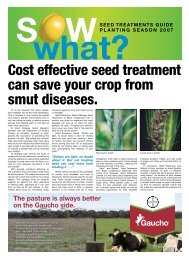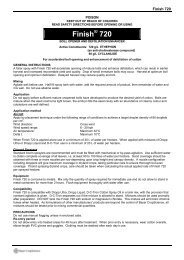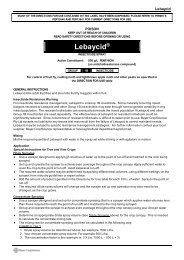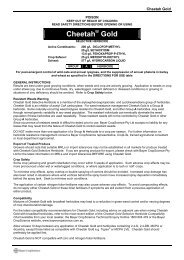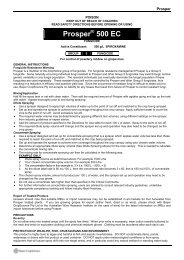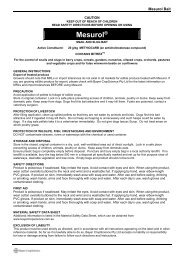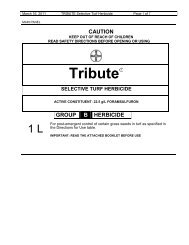TOxICOLOGICAL PROPeRTIeS - Bayer CropScience
TOxICOLOGICAL PROPeRTIeS - Bayer CropScience
TOxICOLOGICAL PROPeRTIeS - Bayer CropScience
You also want an ePaper? Increase the reach of your titles
YUMPU automatically turns print PDFs into web optimized ePapers that Google loves.
index<br />
Introduction 2<br />
Product formulation 2<br />
Toxicological properties 3<br />
Resistance management 4<br />
Biological properties 4<br />
Behaviour in the environment 5<br />
Effects on Flora and Fauna 6<br />
Application 7<br />
Directions for use 7<br />
Weed control – efficacy 8<br />
Compatibility 10<br />
Crop safety 13<br />
General instructions 16<br />
Safety directions 16<br />
INTRODUCTION<br />
Cheetah ® Gold is an Australian innovation<br />
from <strong>Bayer</strong> <strong>CropScience</strong>. Using a<br />
combination of existing chemistry,<br />
Cheetah Gold is formulated to suit local<br />
conditions, providing excellent control of<br />
annual ryegrass and wild oats in wheat<br />
and barley. Cheetah Gold also provides<br />
good suppression of annual phalaris. The<br />
crop safety of Cheetah Gold is enhanced<br />
by the addition of a crop safener in the<br />
formulation.<br />
Active constituent B: 20 g/L sethoxydim<br />
Chemical name:<br />
Structural formula<br />
IUPAC: (+)-(EZ)2-(1-<br />
ethoxyiminobutyl)-5-<br />
[2-(ethylthio)propyl]-3-<br />
hydroxycyclohex-2-enone<br />
CA: (+)-2-[1-(ethoxyimino)butyl]-<br />
5-[2[(ethylthio) propyl]-3-hyroxy-<br />
2-cyclohexen-1-one<br />
<br />
<br />
Poison schedule: 6<br />
<br />
(sethoxydim)<br />
Active constituent C: 13.6 g/L fenoxaprop-P-ethyl<br />
Chemical name: ethyl (R)-2[4(6-chloro-<br />
2-benzoxazolyloxy)-<br />
phenoxy]propanoate<br />
Structural formula<br />
<br />
<br />
<br />
<br />
(fenoxaprop-P-ethyl)<br />
PRODUCT FORMULATION<br />
<br />
Active ingredients<br />
Formulation type:<br />
<br />
<br />
Trade name: Cheetah Gold<br />
Formulation: Emulsifiable concentrate (EC)<br />
Active constituents: A. 200 g/L diclofop-methyl<br />
<br />
B. 20 g/L sethoxydim<br />
C. 13.6 g/L fenoxaprop-P-ethyl<br />
Physical properties<br />
Formulated product (Cheetah Gold):<br />
Appearance: Clear brown liquid<br />
Active constituent A: 200 g/L diclofop-methyl<br />
Odour:<br />
Aromatic hydrocarbon<br />
Chemical name: 2-[4-(2,4-dichlorophenoxy)-<br />
phenoxy]propanoic acid methyl<br />
Flash point: >63°C (closed cup)<br />
ester<br />
Corrosiveness: Not corrosive to glass bottles &<br />
steel containers with polyethylene<br />
Structural formula<br />
coating inside.<br />
Specific gravity: 1.004 at 20°C<br />
Dangerous good: Not classified as a dangerous<br />
<br />
good for road and rail transport.<br />
Solubility in water: Emulsifies in water<br />
<br />
(diclofop-methyl)<br />
<br />
<br />
<br />
<br />
<br />
<br />
<br />
<br />
<br />
TOXICOLOGICAL<br />
PROPERTIES<br />
Oral LD 50 (rat):<br />
Oral LD 50 (rat):<br />
Oral LD 50 (rat):<br />
Dermal LD 50 (rat):<br />
Dermal LD 50 (rat):<br />
Dermal LD 50 (rat):<br />
Inhalation LC 50<br />
(rat) (4 h):<br />
Inhalation LC 50<br />
(rat) (4 h):<br />
Inhalation LC 50<br />
(rat) (4 h):<br />
Skin irritation:<br />
Eye irritation:<br />
512 mg/kg (diclofop-methyl)<br />
2676 mg/kg (sethoxydim)<br />
>3150–4000 mg/kg (fenoxaprop-<br />
P-ethyl)<br />
>2000 mg/kg (diclofop-methyl)<br />
>5000 mg/kg (sethoxydim)<br />
>2000 mg/kg (fenoxaprop-P-ethyl)<br />
>1.36 mg/L (diclofop-methyl)<br />
>6.28 mg/L (sethoxydim)<br />
>0.6 mg/L (fenoxaprop-P-ethyl)<br />
Non-irritating (rabbit)<br />
Non-irritating (rabbit)
RESISTANCE MANAGEMENT<br />
Resistant weeds warning<br />
group A herbicide<br />
Cheetah Gold Selective Herbicide is a member of the<br />
aryloxyphenoxypropionate (‘fop’) and cyclohexanedione<br />
(‘dim’) group of herbicides. Cheetah Gold is an inhibitor<br />
of acetyl-CoA carboxylase. For weed resistance<br />
management, Cheetah Gold is a Group A herbicide.<br />
Some naturally occurring biotypes resistant to Cheetah<br />
Gold and other Group A herbicides may exist through<br />
normal genetic variability in any weed population. The<br />
resistant individuals can eventually dominate the weed<br />
population if these herbicides are used repeatedly.<br />
These resistant weeds will not be controlled by Cheetah<br />
Gold or other Group A herbicides. Since occurrence of<br />
resistant weeds is difficult to detect prior to use, <strong>Bayer</strong><br />
<strong>CropScience</strong> Pty Ltd accepts no liability for any losses<br />
that may result from the failure of Cheetah Gold to<br />
control resistant weeds.<br />
BIOLOGICAL PROPERTIES<br />
Mode of Action<br />
Diclofop-methyl – activity<br />
Diclofop-methyl is primarily taken up through the leaves<br />
and is very quickly transformed to the more phytotoxic<br />
diclofop. The active ingredient is also translocated in<br />
this form in the plant. Penetration and uptake through<br />
the roots is also possible, provided the soil is sufficiently<br />
moist and the application rate relatively high.<br />
The actual site of action is the growing point where<br />
the apical meristem cells are damaged. It is therefore<br />
desirable that the herbicide is deposited near the<br />
growing point.<br />
Diclofop-methyl and diclofop alters cell membrane<br />
functions, prohibiting the translocation of assimilates.<br />
Lipid biosynthesis in the chloroplasts is blocked, which<br />
inhibits plant growth. The chlorophyll content is also<br />
reduced, because the damage to the chloroplast inhibits<br />
photosynthesis.<br />
Diclofop-methyl – uptake and translocation<br />
Diclofop-methyl is absorbed by the leaves and, to some<br />
extent, by roots. Up to 90% of the product can be<br />
absorbed by the leaves within 24 hours. There is virtually<br />
no translocation from sprayed leaves to new leaves,<br />
and very little from roots to leaves. Translocation from<br />
sprayed leaves to the meristematic area does occur, but<br />
is limited (approximately 95% can still be found at the<br />
site of application after 96 hours).<br />
Sethoxydim – activity<br />
The primary mechanism of action of sethoxydim is by<br />
interfering with the lipid metabolism within the plant.<br />
Lipid biosynthesis in the chloroplasts are blocked,<br />
inhibiting growth. The resulting chloroplast damage<br />
inhibits photosynthesis and reduces chlorophyll.<br />
Sethoxydim – uptake and translocation<br />
Sethoxydim is absorbed by the leaves of the emerged<br />
grassweeds and, once inside the plant, rapidly<br />
translocates both acropetally and basipetally throughout<br />
the meristematic region (or growing point). Negligible<br />
amounts of sethoxydim are translocated to the roots.<br />
Fenoxaprop-P-ethyl – activity<br />
Fenoxaprop-P-ethyl is primarily absorbed through the<br />
plant leaves and exhibits limited movement in both<br />
the xylem and phloem. The actual site of action is the<br />
meristematic tissue of the shoot.<br />
Once in the plant, fenoxaprop-P-ethyl is quickly<br />
converted into the free D+ acid fenoxaprop, which<br />
inhibits the biosynthesis of fatty acids. The further<br />
formation of cell membranes in the growing points of<br />
the weed plants is prevented, leading to plant death.<br />
The inhibition of fatty acid biosynthesis leads to other<br />
changes within the weed plant, such as a reduction in<br />
the chlorophyll content due to a reduction of thylacoid<br />
membranes, as well as an increase in soluble sugars<br />
and free amino acids in the stem tissues of the<br />
grassweed plants.<br />
Fenoxaprop-P-ethyl – uptake and translocation<br />
Fenoxaprop-P-ethyl is taken up by the green plant<br />
tissue and transported to the growing points of the leaf<br />
bases, stems and roots. Within the plant, the active<br />
ingredient is rapidly split into the free acid, which is<br />
the compound with the main herbicidal efficacy. The<br />
herbicidal effect of the treatment will be improved if<br />
the spray is applied as close as possible to the sites of<br />
action, and particular attention to application technique<br />
is therefore advised.<br />
Symptoms<br />
After application of Cheetah Gold, grassweeds cease<br />
growth within 2–3 days and chlorosis is observed in the<br />
new leaves. Yellowish/purplish patches appear after<br />
7–10 days (depending on temperature) because of the<br />
chloroplast damage (reduced chlorophyll content) and<br />
the accumulation of anthocyanin pigments. Transport of<br />
assimilates (e.g. carbohydrates) to the roots is inhibited<br />
and the growth of the plant stagnates. After 14–21 days,<br />
all grassweed tissue is damaged and complete necrosis<br />
occurs. Grassweeds can be easily pulled from the<br />
ground because the roots have stopped growing and<br />
the growing point is dead.<br />
BEHAVIOUR IN THE<br />
ENVIRONMENT<br />
In crop<br />
Diclofop-methyl<br />
After absorption of the substance by the green leaf<br />
tissue, diclofop-methyl is hydrolysed to the free acid<br />
diclofop, which is then converted into hydroxylated<br />
metabolites and further metabolised by the plant.<br />
Sethoxydim<br />
Breakdown in plants follows a similar path as in soil<br />
and animals, where the active is broken down rapidly<br />
into metabolites. Sethoxydim degradation is particularly<br />
enhanced by ultraviolet light, mixing with water, and<br />
adsorption onto solid surfaces such as soil.<br />
Fenoxaprop-P-ethyl<br />
Fenoxaprop-P-ethyl is taken up rapidly by the plants<br />
through the leaves and stem and transported to the<br />
sites of action. Further degradation takes place by the<br />
splitting of the benzoxazolyloxy-phenoxy bond. The<br />
resulting metabolites have no herbicidal properties and<br />
are rapidly bound to substances in the plant such as<br />
glucose.<br />
In soil<br />
Diclofop-methyl<br />
During periods of warm weather and with adequate soil<br />
moisture, diclofop-methyl is quickly converted to the<br />
free acid diclofop (DT 50
In water<br />
Diclofop-methyl<br />
Slowly hydrolysed. Breakdown in water is dependent<br />
upon pH, microbial content, oxygen, light and<br />
suspended particles. The purer the water, the slower the<br />
breakdown.<br />
Sethoxydim<br />
Has a short half-life at low pH levels (acidic conditions),<br />
but is very stable in alkaline conditions. Photolysis in<br />
water occurs in less than one hour.<br />
Fenoxaprop-P-ethyl<br />
Degradation studies have shown that, thanks to its<br />
strong adsorption, fenoxaprop-P-ethyl is quickly<br />
removed from water in water/sediment systems. In<br />
water it is also very rapidly degraded by photolysis (halflife<br />
1 day). Hydrolysis to the free acid, with a half-life<br />
of less than 1 day, is also very rapid. The free acid was<br />
degraded in water/sediment with half-lives of 13 to 20<br />
days.<br />
EFFECTS ON FLORA AND<br />
FAUNA<br />
Environment<br />
Cheetah Gold is dangerous to fish and other aquatic<br />
organisms. It is of low toxicity to birds, bees and<br />
earthworms.<br />
DO NOT contaminate streams, rivers or waterways with<br />
Cheetah Gold or the used containers.<br />
In animals<br />
Diclofop-methyl<br />
After oral uptake by rats, diclofop-methyl is rapidly<br />
excreted via the faeces and urine (89% within 2 days).<br />
The excretion takes place in the form of unchanged<br />
active ingredient (up to 20%) as well as conjugated<br />
metabolites.<br />
Diclofop-methyl does not accumulate in animal tissues.<br />
Sethoxydim<br />
Degradation in animals follows similar paths to<br />
degradation in soil and plants, where the active is<br />
broken down rapidly into metabolites.<br />
Fenoxaprop-P-ethyl<br />
Metabolism studies with radioactively labelled active<br />
ingredient in rats showed that over 80% of the<br />
administered product was excreted two days after<br />
oral administration of 10 mg active ingredient/kg body<br />
weight. Excretion was almost complete after seven<br />
days. The metabolites identified were the same as those<br />
in plants and soil.<br />
Fish species Study type/duration LC 50 (mg/L)<br />
Diclofop-methyl Blue gill sunfish (Lepomis macrochirus) Static acute (96-h) 0.24 mg/L<br />
Sethoxydim<br />
Carp (Barbodes)<br />
Rainbow trout (Oncorhynchus mykiss)<br />
Static acute (48-h)<br />
Static acute (48-h)<br />
153 mg/L<br />
38 mg/L<br />
Fenoxaprop-P-ethyl Rainbow trout (Oncorhynchus mykiss) 96-h 0.57 mg/L<br />
Fish food organisms (invertebrates) Study type/duration EC 50 (mg/L)<br />
Diclofop-methyl Water flea (Daphnia magna) Static acute (48-h) 0.23 mg/L<br />
Sethoxydim Water flea (Daphnia magna) Static acute (3-h) 1.5 mg/L<br />
Fenoxaprop-P-ethyl Water flea (Daphnia magna) Static acute (48-h) 1.058 mg/L<br />
Bird species Study type/duration LD 50 (mg/L)<br />
Diclofop-methyl Japanese quail (Coturnix japonica) 14-day acute oral >10000 mg/L<br />
Sethoxydim Japanese quail (Coturnix japonica) 14-day acute oral >5000 mg/kg<br />
Fenoxaprop-P-ethyl Japanese quail (Coturnix japonica) Acute oral >2000 mg/kg<br />
APPLICATION<br />
Application of Cheetah Gold should be directed at the<br />
base (meristematic tissue or growing tip) of the weed for<br />
good results (as shown by the diagram below). It is also<br />
important to use the right combination of type and size<br />
of nozzle and correct droplet size, with adequate spray<br />
volume and pressure. Use small droplets (200 to 300<br />
microns) and aim for a droplet density of approximately<br />
25 to 50 droplets per cm 2 .<br />
<br />
<br />
<br />
<br />
<br />
<br />
<br />
Mixing:<br />
Add the required quantity of Cheetah Gold directly to<br />
the spray tank when about two-thirds full. Top up with<br />
water to the required volume, with agitation operating<br />
after adding broadleaf herbicides if required.<br />
<br />
Surfactant:<br />
Uptake ® 0.5% v/v or Hasten ® 1% v/v<br />
Rainfast:<br />
4 hours<br />
Water quality:<br />
Diclofop-methyl and fenoxaprop-P-ethyl are unstable<br />
in alkaline conditions, while sethoxydim is unstable in<br />
acidic conditions. Clean water with water hardness of<br />
DIRECTIONS FOR USE<br />
<br />
1000 ppm or less with a neutral pH (pH 7) is ideal. Do not<br />
leave Cheetah Gold mixed in the tank for prolonged<br />
periods (greater than 6 hours).<br />
Ground-rig application<br />
Only standard boom sprays are recommended and they<br />
must be fitted with by-pass or mechanical agitation.<br />
Do not apply with boomless jets or misters.<br />
Trials over past years have clearly shown which conditions<br />
produce more consistent and reliable results:<br />
• Higher water volumes (i.e. 60 to 100 L/ha) were more<br />
consistent than 30 to 40 L/ha.<br />
• Slower speeds (i.e. 10 to 15 km/hr) were more<br />
consistent than faster speeds (18 to 24 km/hr).<br />
• Wide-angle nozzles (i.e. 110° flat-fan jets) were more<br />
consistent than 80° jets.<br />
On the basis of this work, and experience with the<br />
product, we strongly suggest the following:<br />
Nozzles: Use 110° nozzles set up as the<br />
manufacturers recommend, i.e. Spraying<br />
Systems nozzles 11002 at 50 cm spacings<br />
for single overlap in order to achieve a<br />
droplet size of 200–300 microns. This<br />
equates to a FINE/MEDIUM spray as<br />
defined by the ASAE S572 Standard.<br />
Nozzles creating coarse or very coarse<br />
spray qualities have not been thoroughly<br />
investigated at this time and cannot be<br />
recommended.<br />
Speed: Maximum 16 km/hr to avoid excessive<br />
boom instability.<br />
Pressure: 280 to 300 kPa (approx. 40 to 43 psi).<br />
Water volumes: Minimum 50 L/ha up to 150 L/ha.<br />
Aerial application<br />
Cheetah Gold is not recommended for aerial application,<br />
because of the high risk associated with overlap.<br />
Restraints<br />
DO NOT apply to any crop other than barley or wheat.<br />
DO NOT apply to crops that are physically damaged (e.g. by hail, wind, insect attack).<br />
DO NOT allow spray overlap or double-spraying of corners.<br />
DO NOT apply to weeds or crops under stress due to for example, very dry, very wet, nutrient-deficient, frosty or<br />
diseased conditions, or as the result of a previous herbicide or foliar fertiliser treatment (see also General Instructions<br />
on the product label for further detail).<br />
DO NOT apply if rainfall is expected within 4 hours.<br />
Crop Weed State Weed stage Rate (L/ha) Critical comments<br />
Barley,<br />
wheat<br />
Wild oats<br />
(Avena spp.),<br />
Annual ryegrass<br />
(Lolium rigidum)<br />
Suppression of<br />
annual phalaris<br />
(Phalaris paradoxa)<br />
Qld, NSW,<br />
ACT, Vic,<br />
Tas, SA,<br />
WA, only<br />
2–leaf to<br />
2–tiller<br />
(Z12 to Z14,<br />
22)<br />
1.0 Apply generally 3 to 6 weeks after sowing<br />
when the crop is usually 2–leaf to 2–tiller<br />
(Z12 to Z14, 22)<br />
Cheetah Gold must be mixed with one of the<br />
following adjuvants:<br />
Uptake at 0.5% v/v or Hasten at 1.0% v/v.
WEED CONTROL – EFFICACY<br />
The efficacy of Cheetah Gold is related to growing<br />
conditions. Results under poor growth situations (e.g.<br />
low or excess moisture, temperatures not favourable to<br />
weed growth or poor nutrition) may be inferior to those<br />
achieved under good conditions. High temperatures<br />
(>25°C) do not favour the growth of ryegrass, so the<br />
herbicidal effect may be reduced. The effect on young<br />
plants is always better than on old plants.<br />
Graph 1. Annual ryegrass control with Cheetah Gold<br />
% annual ryegrass control<br />
100<br />
95<br />
90<br />
85<br />
80<br />
75<br />
70<br />
65<br />
Cheetah Gold<br />
1 L/ha #<br />
Trial ID: 04NW16, 04VB12, 06NB01, 06NB22<br />
Achieve ®<br />
Cheetah Gold<br />
380 g/ha ¤ 1 L/ha #<br />
Trial ID: 05NW16, 05NW17, 05VA17<br />
Mild, wet weather encourages plant growth and<br />
increases the activity of Cheetah Gold. Hot, dry or<br />
excessively cold weather slows activity.<br />
Annual ryegrass<br />
Cheetah Gold is an excellent herbicide for the control<br />
of annual ryegrass. Cheetah Gold has a unique<br />
combination of a ‘fop’ & ‘dim’ Group A chemicals to<br />
provide this control in wheat and barley.<br />
Axial ®<br />
300 mL/ha*<br />
# Hasten 1% v/v or Uptake 0.5% v/v *Adigor ® 0.5% v/v ¤ Supercharge ® 0.75% v/v<br />
Cheetah Gold<br />
1 L/ha #<br />
Tristar ® Advance<br />
1.5 L/ha<br />
Trial ID: 04NW16, 04WA11, 04NB08, 04VB12, 05VA15, 05VB06,<br />
05NW16, 05NW17, 05VA16, 05VA17, 05NB06, 05NB04, 05NB12,<br />
06NB01, 06NB02, 06NB22<br />
Cheetah Gold is not a suitable herbicide where resistance levels to Group A products are high, with Cheetah Gold<br />
showing a slight improvement over Tristar Advance.<br />
Graph 2. Cheetah Gold versus Tristar Advance<br />
% annual ryegrass control<br />
100<br />
90<br />
80<br />
70<br />
60<br />
50<br />
04NB08<br />
04VB12<br />
05VB06<br />
During 2006, a glasshouse study was conducted by<br />
researchers at Charles Sturt University. Ten annual<br />
ryegrass samples were sprayed with Cheetah Gold,<br />
Achieve and Axial. Five of the annual ryegrass samples<br />
were ‘fop’ resistant and five were both ‘fop’ and ‘dim’<br />
resistant. Cheetah Gold, being a mixture of a ‘fop’ and<br />
‘dim’ herbicide, did not effectively control the ‘fop’ and<br />
‘dim’ resistant annual ryegrass, as shown by the graph<br />
below. Despite Achieve and Axial providing slightly<br />
better levels of control than Cheetah Gold, the results<br />
would still be considered commercially unacceptable.<br />
<br />
05VA15<br />
05NW16<br />
05NB06<br />
05NB04<br />
Trial ID<br />
Resistance developing<br />
05NW17<br />
% annual ryegrass control<br />
05NB12<br />
04WA11<br />
05VA17<br />
04NW16<br />
05VA16<br />
05VB07<br />
Graph 3. Performance of Cheetah Gold on<br />
confirmed resistant annual ryegrass<br />
100<br />
90<br />
80<br />
70<br />
60<br />
50<br />
40<br />
30<br />
Cheetah Gold Achieve Axial<br />
1 L/ha # 380 g/ha ¤ 300 mL/ha*<br />
Trial ID: Screening of Group A resistant annual ryegrass samples to<br />
selected herbicies, 2006. Charles Sturt University.<br />
Highest<br />
result<br />
Average<br />
result<br />
Lowest<br />
result<br />
Cheetah<br />
Gold<br />
1 L/ha<br />
(Hasten<br />
1% v/v or<br />
Uptake<br />
0.5% v/v)<br />
Tristar<br />
Advance<br />
1.5 L/ha<br />
Highest<br />
result<br />
Average<br />
result<br />
Lowest<br />
result<br />
# Hasten 1% v/v *Adigor 0.5% v/v ¤ Supercharge 0.75% v/v<br />
Wild oats<br />
Cheetah Gold provides excellent control of wild oats.<br />
Graph 4. Wild oat control with Cheetah Gold<br />
% wild oat control<br />
% wild oat control<br />
100<br />
95<br />
90<br />
85<br />
80<br />
75<br />
70<br />
65<br />
100<br />
95<br />
90<br />
85<br />
80<br />
75<br />
70<br />
65<br />
Cheetah Gold<br />
1 L/ha #<br />
Trial ID: 04VB06, 04VB12, 05NB05, 05NB07, 05QG22,<br />
06NB01, 06NB22<br />
Cheetah Gold<br />
1 L/ha #<br />
Trial ID: 04ND01, 04SA43, 04NB08, 05NB05, 06NB01, 06NB02,<br />
06NB22<br />
Achieve<br />
Cheetah Gold<br />
380 g/ha ¤ 1 L/ha<br />
Axial<br />
200 mL/ha*<br />
Trial ID: 05ND12, 05VB07, 05QG22, 05NB11, 05NB12. 06NB01,<br />
06NB02, 06NB22<br />
# Hasten 1% v/v or Uptake 0.5% v/v *Adigor 0.5% v/v ¤ Supercharge 0.75% v/v<br />
Wildcat ®<br />
Cheetah Gold<br />
300 mL/ha † 1 L/ha<br />
# Hasten 1% v/v † BS1000 ® 0.25% v/v ** Hasten 0.5% v/v<br />
Annual phalaris<br />
Topik ®<br />
65 mL/ha **<br />
Trial ID: 04NB08, 05NB05, 06NB01, 06NB02, 06NB22<br />
The performance of Cheetah Gold on annual phalaris is<br />
variable, as demonstrated by the control achieved in the<br />
trials below. <strong>Bayer</strong> <strong>CropScience</strong> can therefore only make<br />
a suppression claim.<br />
Graph 5. Annual-phalaris control with Cheetah Gold<br />
% annual phalaris control<br />
100<br />
95<br />
90<br />
85<br />
80<br />
75<br />
70<br />
65<br />
Cheetah Gold<br />
1 L/ha #<br />
Axial<br />
200 mL/ha*<br />
Trial ID: 05QG22, 05NB12, 06ND11, 06NW17, 06NB01<br />
# Hasten 1% v/v *Adigor 0.5% v/v<br />
Cheetah Gold<br />
1 L/ha<br />
Hussar ®<br />
200 g/ha #<br />
Trial ID: 04NB10, 05QG22, 05NB04, 05NB12,06ND11, 06NW17,<br />
06NB01, 06NB10<br />
Cheetah Gold<br />
1 L/ha #<br />
Tristar Advance<br />
1.5 L/ha<br />
Trial ID: 04ND01, 04NW15, 04WB13, 04VB11, 04SA43, 04QG04,<br />
04NB08, 04VB06, 04VB12, 05ND09, 05WA15, 05VB06, 05SA12,<br />
05NW14, 05ND11, 05ND12, 05VA16, 05VA17, 05VB07, 05SA15,<br />
05QG22, 05NB05, 05NB07, 05NB11, 05NB12, 06NB01, 06NB02,<br />
06NB22<br />
Highest<br />
result<br />
Average<br />
result<br />
Lowest<br />
result<br />
Highest<br />
result<br />
Average<br />
result<br />
Lowest<br />
result<br />
Highest<br />
result<br />
Average<br />
result<br />
Lowest<br />
result
COMPATIBILITY<br />
With mixed infestations of grass and broadleaf weeds,<br />
the flexibility to choose effective and economical<br />
combinations is crucial.<br />
Mixtures of Cheetah Gold with broadleaf herbicides<br />
may lead to a reduction in grassweed control or an<br />
increase in crop effects. These effects can be minimised<br />
by closely following all use recommendations and<br />
restrictions.<br />
Allow at least 10 days between any application of<br />
Cheetah Gold and herbicides containing 2,4-D, 2,4-DB,<br />
MCPA or dicamba, except those listed as compatible<br />
with Cheetah Gold e.g. Tigrex ® or MCPA LVE. Cheetah<br />
Gold should preferably be applied first.<br />
The following table summarises the current knowledge<br />
on compatibility.<br />
Graph 6. Wild oat control with mixtures of Cheetah Gold 1 L/ha and broadleaf herbicides<br />
% wild oat control<br />
100<br />
95<br />
90<br />
85<br />
80<br />
75<br />
Product Annual ryegrass Wild oats Annual phalaris<br />
Tigrex 750 mL # *<br />
Jaguar ® 750 mL^<br />
*<br />
MCPA LVE 700 mL *<br />
Lontrel ® 120 g/ha *<br />
Eclipse ® 7 g/ha *<br />
Buctril ® MA 1.4 L/ha *<br />
Broadstrike ® 25 g/ha *<br />
Le-Mat ® 100 mL *<br />
# Equivalent to Giant ® at 900 mL/ha<br />
^ Equivalent to Barracuda ® at 900 mL/ha<br />
Trials indicate no reduction in grassweed<br />
control when used as recommended. Results at below<br />
recommended rates may indicate some reduction in<br />
some cases. Mixtures may be used with minimal loss<br />
of activity under good growing conditions, with all label<br />
recommendations followed.<br />
Trials indicate some reduction in grassweed<br />
control and increased crop effects at recommended<br />
rates, even under good growing conditions. Mixtures<br />
will usually result in reduced grassweed control and<br />
cannot be recommended unless such efficacy loss is<br />
accepted. Under stressed conditions results could be<br />
unacceptable.<br />
No data available.<br />
* Based on best information available.<br />
With the addition of a broadleaf herbicide to Cheetah<br />
Gold, the efficacy on annual ryegrass and wild oats<br />
can vary. Graph 6 shows the level of wild oat control<br />
achieved by adding a range of broadleaf herbicides.<br />
The range of broadleaf herbicides that can be mixed<br />
with Cheetah Gold to control annual phalaris is limited.<br />
In this situation, a true 1-OnePass ® product such as<br />
Hussar Selective Herbicide may need to be used.<br />
For information on other compatibilities contact your<br />
local <strong>Bayer</strong> <strong>CropScience</strong> representative.<br />
70<br />
Cheetah Gold<br />
1 L/ha # + Tigrex<br />
750 mL/ha*<br />
Trial ID: 06ND08, 06NW13, 06ND18, 06VB11, 06QC08<br />
* BS1000 0.25% v/v # Uptake 0.5% v/v<br />
+ Jaguar<br />
750 mL/ha*<br />
Crop safety can also be compromised with the addition<br />
of a broadleaf herbicide to Cheetah Gold. Graphs 7 and<br />
8 show the effect on crop safety of adding a range of<br />
broadleaf herbicides.<br />
+ MCPA LVE + Lontrel + Eclipse + Buctril MA + Broadstrike + Le-Mat<br />
700 mL/ha # 750SG 7 g/ha # 1.4 L/ha # 25 g/ha # 100 mL/ha #<br />
120 g/ha #<br />
Graph 7. Cheetah Gold plus broadleaf herbicide – maximum biomass reduction<br />
% maximum biomass reduction<br />
10<br />
8<br />
6<br />
4<br />
2<br />
0<br />
Cheetah Gold<br />
1 L/ha # + Tigrex<br />
750 mL/ha*<br />
+ Jaguar<br />
750 mL/ha*<br />
Trial ID: 06NW13, 06ND18, 06ND19, 06VB11, 06ND10, 06NW15, 06ND20, 06WA15<br />
* BS1000 0.25% v/v # Uptake 0.5% v/v or Hasten 1.0% v/v<br />
+ MCPA LVE + Lontrel + Eclipse + Buctril MA + Broadstrike + Le-Mat<br />
700 mL/ha # 750SG 7 g/ha # 1.4 L/ha # 25 g/ha # 100 mL/ha #<br />
120 g/ha #<br />
Graph 8. Cheetah Gold plus broadleaf herbicides – maximum discolouration<br />
20<br />
% discolouration<br />
15<br />
10<br />
5<br />
Cheetah Gold<br />
1 L/ha # + Tigrex<br />
750 mL/ha*<br />
+ Jaguar<br />
750 mL/ha*<br />
Trial ID: 06ND08, 06NW13, 06ND18, 06ND19, 06VB11, 06QC08, 06ND10,<br />
06NW15, 06ND20, 06WA15<br />
* BS1000 0.25% v/v # Uptake 0.5% v/v or Hasten 1.0% v/v<br />
+ MCPA LVE + Lontrel + Eclipse + Buctril MA + Broadstrike + Le-Mat<br />
700 mL/ha # 750SG 7 g/ha # 1.4 L/ha # 25 g/ha # 100 mL/ha #<br />
120 g/ha #<br />
10 11
Foliar fertilisers<br />
Glasshouse pot trials in Western Australia by Robson<br />
and Snowball (1989) demonstrated soil-incorporated<br />
diclofop-methyl (a key component of Cheetah Gold)<br />
could induce zinc deficiency in wheat.<br />
Graph 9. Wild oat control with Cheetah Gold plus foliar zinc fertiliser<br />
% wild oat control<br />
100<br />
95<br />
90<br />
85<br />
80<br />
75<br />
70<br />
Cheetah Gold<br />
1 L/ha + Uptake 0.5% v/v<br />
Trial ID: 05ND11, 05ND12, 05VA16, 05VA17, 05VB07, 05SA15<br />
Cheetah Gold 1 L/ha<br />
+ Uptake 0.5% v/v<br />
+ Twin Zinc 350 mL/ha<br />
Trials indicate that the addition of zinc oxide to Cheetah<br />
Gold has a negative impact on wildoat control, as shown<br />
by the graph below.<br />
No information is available on mixtures with other foliar<br />
fertilisers, and therefore cannot be recommended.<br />
Cheetah Gold 1 L/ha<br />
+ Hasten 1% v/v<br />
Cheetah Gold 1 L/ha<br />
+ Hasten 1% v/v<br />
+ Twin Zinc 350 mL/ha<br />
Annual ryegrass control is affected less than wild oats if foliar zinc is added to Cheetah Gold.<br />
Graph 10. Annual ryegrass control with Cheetah Gold plus foliar zinc fertiliser<br />
% annual ryegrass control<br />
100<br />
95<br />
90<br />
85<br />
80<br />
75<br />
70<br />
Cheetah Gold<br />
1 L/ha + Uptake 0.5% v/v<br />
Trial ID: 05NW16, 05NW17, 05VA16, 05VA17<br />
NB. VA16 and VA17 low levels of Group A resistance developing.<br />
Cheetah Gold 1 L/ha<br />
+ Uptake 0.5% v/v<br />
+ Twin Zinc 350 mL/ha<br />
Cheetah Gold 1 L/ha<br />
+ Hasten 1% v/v<br />
Cheetah Gold 1 L/ha<br />
+ Hasten 1% v/v<br />
+ Twin Zinc 350 mL/ha<br />
Highest<br />
result<br />
Average<br />
result<br />
Lowest<br />
result<br />
Highest<br />
result<br />
Average<br />
result<br />
Lowest<br />
result<br />
CROP SAFETY<br />
Crop discolouration and biomass reductions<br />
Cheetah Gold can cause crop discolouration shortly<br />
after application. The typical symptoms include<br />
yellowing of the plant material. Diclofop-methyl<br />
penetrates the cuticle and epidermis rapidly, but<br />
translocation in the phloem is relatively slow. Movement<br />
in the xylem is more rapid, leading to an accumulation<br />
of active ingredient at the leaf tips. This can result in<br />
burning of the wheat and barley leaf tips. Transient<br />
Graph 11. Maximum crop discolouration in wheat trials – Cheetah Gold 1 L/ha<br />
% maximum crop discolouration<br />
in wheat trials<br />
% maximum crop discolouration<br />
in barley trials<br />
30<br />
25<br />
20<br />
15<br />
10<br />
5<br />
0<br />
30<br />
25<br />
20<br />
15<br />
10<br />
5<br />
0<br />
06ND08<br />
06ND06<br />
05WA16<br />
06ND10<br />
05ND12<br />
06ND19<br />
06ND09<br />
05ND09<br />
06NW13<br />
06ND17<br />
05ND11<br />
05SA12<br />
05WA15<br />
05VB07<br />
06NW17<br />
04WB13<br />
04ND01<br />
06SA55<br />
05VA16<br />
05WA12<br />
04ND23<br />
06WB08<br />
06NW14<br />
06ND11<br />
05NW15<br />
05SA15<br />
05NW16<br />
05WB07<br />
05WB06<br />
04SA44<br />
04SA43<br />
05WA14<br />
04WA10<br />
04VB12<br />
06ND18<br />
04VB09<br />
06NW15<br />
06ND07<br />
04VB11<br />
05NW17<br />
05WA17<br />
05WB05<br />
06NW11<br />
06VB06<br />
Adjuvant Hasten 1% v/v or Uptake 0.5% v/v<br />
04QG10<br />
04QG08<br />
05ND08<br />
05ND10<br />
05SA14<br />
05SA11<br />
ND32/05<br />
04WA11<br />
05WB17<br />
05WB27<br />
06ND20<br />
06NW08<br />
04SA44<br />
Trial ID<br />
Graph 12. Maximum crop discolouration in barley trials – Cheetah Gold 1 L/ha<br />
04ND23<br />
06WA14<br />
06SA55<br />
whitening at the base of new leaf emergence may occur,<br />
affecting new growth.<br />
Under cold, wet, waterlogged conditions or nutrient<br />
stress, these crop effects can be severe. Older leaves<br />
turn yellow and there is significant necrosis. New<br />
growth is unaffected and the crop recovers in<br />
about 4 weeks. In some cases new growth may show<br />
transient whitening and growth may be slowed. The<br />
maximum effect is 21–28 days after application, with<br />
recovery being 40–60 days after application. Where<br />
plants have been double-sprayed through overlap,<br />
effects may remain noticeable up to harvest.<br />
SA42/05<br />
04VB09<br />
05VA14<br />
05VA15<br />
05VB06<br />
05VA17<br />
05NW15<br />
05WB28<br />
ND31/05<br />
04ND21<br />
06WA15<br />
06QC08<br />
Adjuvant Hasten 1% v/v or Uptake 0.5% v/v<br />
Trial ID<br />
12 13
05WB17<br />
Graph 13. Maximum biomass reduction in wheat trials – Cheetah Gold 1 L/ha<br />
% maximum biomass reduction<br />
20<br />
16<br />
12<br />
8<br />
4<br />
0<br />
05NW16<br />
05ND12<br />
06WB08<br />
06ND11<br />
04WB13<br />
05VA16<br />
05WA16<br />
04WA10<br />
04SA43<br />
05WA14<br />
04VB06<br />
Adjuvant Hasten 1% v/v or Uptake 0.5% v/v<br />
05WB05<br />
05WB07<br />
06ND09<br />
05WA15<br />
04ND23<br />
06ND19<br />
04SA44<br />
04NW16<br />
05WA17<br />
05WB06<br />
06ND10<br />
06NW14<br />
06ND07<br />
06ND07<br />
06SA55<br />
Trial ID<br />
Graph 14. Maximum biomass reduction in barley trials – Cheetah Gold 1 L/ha<br />
% maximum biomass reduction<br />
20<br />
16<br />
12<br />
8<br />
4<br />
0<br />
05SA14<br />
04ND21<br />
05SA11<br />
05ND08<br />
ND32/05<br />
05WB27<br />
05ND10<br />
04WA11<br />
04ND23<br />
06WA14<br />
04SA44<br />
SA42/05<br />
05WB28<br />
05VA14<br />
05WA12<br />
06SA55<br />
05NW14<br />
06ND18<br />
06NW17<br />
04ND01<br />
05NW15<br />
04VB11<br />
04VB12<br />
05SA12<br />
05ND09<br />
05ND11<br />
05SA15<br />
05NW17<br />
05VB07<br />
04VB09<br />
06NW13<br />
06NW15<br />
06ND17<br />
06NW11<br />
06VB06<br />
04QG08<br />
04QG10<br />
05VA15<br />
05VB06<br />
05VA17<br />
05NW15<br />
ND31/05<br />
04VB09<br />
06WA15<br />
06ND20<br />
06NW08<br />
The addition of Uptake 0.5% v/v in preference to Hasten 1% v/v has very little impact on annual ryegrass and wild oat<br />
control, as shown by the graph below.<br />
Graph 16. Annual ryegrass and wild oat control with Cheetah Gold 1 L/ha plus Hasten 1% v/v or Uptake 0.5% v/v.<br />
% control<br />
100<br />
95<br />
90<br />
85<br />
80<br />
Crop yield<br />
Cheetah Gold 1 L/ha<br />
+ Hasten 1% v/v<br />
ANNUAL RYEGRASS<br />
Cheetah Gold 1 L/ha<br />
+ Uptake 0.5% v/v<br />
Trial ID annual ryegrass: 05NW16, 05NW17, 05VA16, 05VA17<br />
100<br />
Trial ID wild oats: 0 5ND11, 05ND12, 05VA16, 05VA17, 05VB07, 05SA15, 06QC08, 06NW13, 06VB11, 06ND08, 06ND18<br />
The crop rapidly recovers from effects such as biomass<br />
reductions and crop discolouration, ensuring that crop<br />
yield is unaffected. When used at 1 L/ha, Cheetah<br />
% control<br />
95<br />
90<br />
85<br />
80<br />
Cheetah Gold 1 L/ha<br />
+ Hasten 1% v/v<br />
WILD OATS<br />
Cheetah Gold 1 L/ha<br />
+ Uptake 0.5% v/v<br />
Highest<br />
result<br />
Average<br />
result<br />
Lowest<br />
result<br />
Gold produces a very similar yield to the industry<br />
standard, Tristar Advance. The graph below shows their<br />
comparative performances in a weed-free situation.<br />
Adjuvant Hasten 1% v/v or Uptake 0.5% v/v<br />
Trial ID<br />
Surfactants/Adjuvants<br />
Cheetah Gold has been tested with both Hasten 1% v/v<br />
and Uptake 0.5% v/v in order to determine differences in<br />
crop safety. The trials below show that Uptake 0.5% v/v<br />
does provide an improvement in crop selectivity in both<br />
wheat and barley when compared to Hasten 1% v/v.<br />
If crop selectivity is a potential concern, Uptake 0.5%<br />
v/v should be used in preference to Hasten 1% v/v.<br />
Graph 15. Maximum discolouration and biomass reduction ratings for both Hasten 1% v/v and Uptake 0.5% v/v<br />
Graph 17. Wheat yields – Cheetah Gold versus Tristar Advance (% of untreated)<br />
% maximum discolouration<br />
and biomass reduction<br />
30<br />
25<br />
20<br />
15<br />
10<br />
5<br />
0<br />
Cheetah Gold 1 L/ha<br />
+ Hasten 1% v/v<br />
WHEAT<br />
Cheetah Gold 1 L/ha<br />
+ Uptake 0.5% v/v<br />
% maximum discolouration<br />
and biomass reduction<br />
Trial ID wheat: 05ND11, 05ND12, 0SA15, 05NW16, 05NW17, 05VB07, 05WA17, 05VA16, 06ND08, 06ND18, 06ND19, 06ND10, 06NW15<br />
Trial ID barley: 05VA17, 05ND10, 05NW15, 05SA14, 06WA15, 06NW13, 06ND20, 06QC08<br />
30<br />
25<br />
20<br />
15<br />
10<br />
5<br />
0<br />
Cheetah Gold 1 L/ha<br />
+ Hasten 1% v/v<br />
BARLEY<br />
Cheetah Gold 1 L/ha<br />
+ Uptake 0.5% v/v<br />
Highest<br />
result<br />
Average<br />
result<br />
Lowest<br />
result<br />
Wheat yields as a % of untreated<br />
110<br />
100<br />
90<br />
80<br />
70<br />
60<br />
50<br />
40<br />
30<br />
05WA12<br />
05WB05<br />
05WB07<br />
05WA16<br />
06NW14<br />
06ND09<br />
06WB08<br />
05ND08<br />
05SA11<br />
05ND10<br />
05NW15<br />
05SA14<br />
05WB27<br />
05WB28<br />
05SA42<br />
05ND31<br />
05ND32<br />
06WA14<br />
Cheetah<br />
Gold<br />
1 L/ha<br />
Tristar<br />
Advance<br />
1.5 L/ha<br />
Cheetah Gold: Adjuvant Hasten 1% v/v or Uptake 0.5% v/v<br />
Trial ID<br />
14 15
GENERAL INSTRUCTIONS<br />
Protection of wildlife, fish, crustaceans and<br />
environment<br />
Dangerous to fish and other aquatic organisms.<br />
DO NOT contaminate streams, rivers or waterways with<br />
this product or the used container.<br />
Protection of crops, native and other nontarget<br />
plants<br />
DO NOT apply under weather conditions or from<br />
spraying equipment which would be expected to cause<br />
spray to drift onto nearby susceptible plants (e.g. cereals<br />
other than barley or wheat, maize, sweetcorn, sorghum,<br />
rice or turf grasses), adjacent crops, crop lands or<br />
pasture.<br />
DO NOT plant susceptible crops (e.g. maize, sorghum,<br />
rice) for 10 weeks after application.<br />
Undersown clovers and medics<br />
Cheetah Gold does not affect undersown clovers or<br />
medics or other broadleaf crops.<br />
Storage and disposal<br />
Store in the closed, original container in a cool, wellventilated<br />
area. Do not store for prolonged periods in<br />
direct sunlight.<br />
Triple or preferably pressure rinse containers before<br />
disposal. Add rinsings to spray tank. Do not dispose of<br />
undiluted chemicals on site. If recycling, replace cap<br />
and return clean containers to recycler or designated<br />
collection point. If not recycling, break, crush or<br />
puncture and bury empty containers in a local authority<br />
landfill. If no landfill is available, bury the containers<br />
below 500 mm in a disposal pit specifically marked and<br />
set up for this purpose clear of waterways, desirable<br />
vegetation and tree roots. Empty containers and product<br />
should not be burnt. Do not re-use empty container for<br />
any other purpose.<br />
SAFETY DIRECTIONS<br />
Harmful if absorbed by skin contact, inhaled or<br />
swallowed. Will irritate the eyes and skin. Repeated<br />
exposure may cause allergic disorders. Avoid contact<br />
with eyes and skin. Do not inhale vapour or spray mist.<br />
When opening the container and preparing spray,<br />
wear cotton overalls buttoned to the neck and wrist, a<br />
washable hat, elbow-length PVC gloves, goggles and a<br />
disposable mist face mask covering mouth and nose.<br />
When using the prepared spray, wear cotton overalls<br />
buttoned to the neck and wrist (or equivalent clothing).<br />
If clothing becomes contaminated with product or wet<br />
with spray, remove clothing immediately. If product or<br />
spray on skin, immediately wash area with soap and<br />
water. If product or spray in eyes, wash it out immediately<br />
with water. Wash hands after use. After each day's use,<br />
wash gloves, goggles and contaminated clothing.<br />
First Aid<br />
If poisoning occurs, contact a doctor or Poisons<br />
Information Centre (telephone 13 11 26). If swallowed,<br />
do NOT induce vomiting. Give a glass of water.<br />
Material safety data sheet<br />
Additional information is listed in the Material<br />
Safety Data Sheet, which can be obtained from<br />
www.bayercropscience.com.au<br />
For post-emergent control of<br />
annual ryegrass, wild oats and<br />
for the suppression of annual<br />
phalaris in wheat and barley<br />
technical guide<br />
<strong>Bayer</strong> <strong>CropScience</strong> Pty Ltd,<br />
ABN. 87 000 226 022<br />
391–393 Tooronga Road<br />
Hawthorn East, Vic 3123<br />
Ph: (03) 9248 6888<br />
Fax: (03) 9248 6800<br />
www.bayercropscience.com.au<br />
Technical enquiries: 1800 804 479<br />
Disclaimer<br />
Always read the label for full instructions.<br />
The information and recommendations set out in this brochure are based on tests<br />
and data believed to be reliable at the time of publication. Results may vary, as<br />
the use and application of the products is beyond our control and may be subject<br />
to climatic, geographical or biological variables, and/or developed resistance.<br />
Any product referred to in this brochure must be used strictly as directed, and<br />
in accordance with all instructions appearing on the label for that product and in<br />
other applicable reference material. So far as it is lawfully able to do so, <strong>Bayer</strong><br />
<strong>CropScience</strong> Pty Ltd accepts no liability or responsibility for loss or damage<br />
arising from failure to follow such directions and instructions.<br />
Cheetah ® , 1-OnePass ® , Hussar ® , Jaguar ® , Eclipse ® , Buctril ® , Wildcat ® ,<br />
Tigrex ® , Giant ® , Barracuda ® and Tristar ® are Registered Trademarks of <strong>Bayer</strong>.<br />
Le-mat ® is a Registered Trademark of Arysta.<br />
BCB 021



